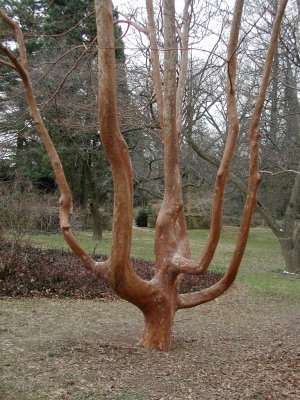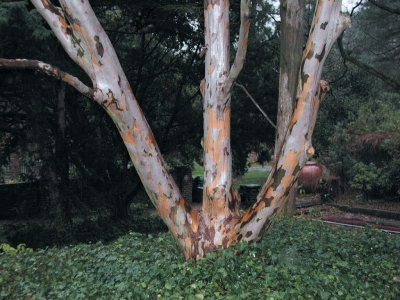CHANGING STEMS, CHANGING LEAVES
Korean Giant Pear, In Training
Stepping down the two stones at one end of my bluestone wall, a friend looked up and asked, “Are you torturing or training this tree?” He was referring to the tree on one side of the the stairway, one long stem of which was arching overhead, held in that position with a string tied to a stone on the opposite side of the stairway.
“Training,” I replied. The stem was being coaxed into this seemingly submissive position both for form and function. Not to inflict pain.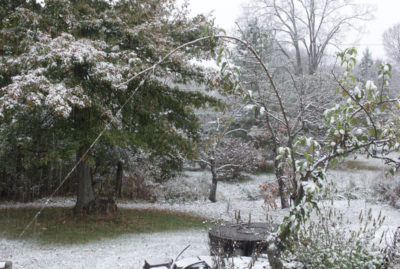
But first, something about this tree. It is an Asian pear, the variety Seuri Li that I created many years ago by grafting a Seuri Li stem on a semi-dwarfing rootstock (OH x F 513). It’s initial training was as an en arcure espalier. Deer found the young pear trees sitting high enough on the backfilled soil behind the wall a convenient smorgasbord; they didn’t even have to bend down to nibble at them. So the espalier became a deer-modified en arcure.
Seuri Li never bore as well as the other Asian pears — Yoinashi, Yakumo, and Chojuro — trained above that wall. Last year I lopped back one major stem of Seuri Li and grafted a stem of the variety Korean Giant onto the stump. The graft “took,” and fueled by the established root system, buds from the grafted stem soared skyward.
Growth from the graft was vigorous enough to start a large arch over the two stone stairway. A very big en arcure.
Hormonal Control
Training to en arcure entails bending the single stem of a young fruit tree over to its neighbor. Typically, a bud near the high point of the arch will grow out into a vigorous shoot which is then bent in an arch in the opposite direction, to its neighbor on the other side. The vigorous shoot growing from the high point of that second arch is trained back to the next tier of arch of first neighbor. And so on, as high as desired.
The end result is a flat plane of adjacent trees decoratively linked as a living fence.
The fence might be considered functional, but the truly functional aspect of en arcure is physiological. Enhanced vigor of the highest buds can be traced to a plant hormone, auxin. Auxin, present in all plants, is synthesized in the uppermost growing points of a plant, either the tip of a vertical stem or the high point of an arched stem. But this auxin also puts the brakes, to some degree, on growth from buds below that high point.
Growing fruit takes energy, as does growing stems; more fruit means less stem growth, and vice versa. (Left to their own devices, plants more or less balance these needs themselves, although not always to our satisfaction, which is why you have to pluck off peach fruitlets so that a peach tree can pump more energy into the fewer — and resulting — tastier fruits that remain.) Bending a branch over quells its growth, coaxing it to divert more energy to making fruit — except for the uppermost bud, which puts out a vigorous shoot.
My plan, then, is to have that long stem of Korean Giant pear festooned with flowers in spring and fruits in autumn as it arches over the stone stairs. Plants don’t read plant physiology books and tow the line to all this theory, but I’m confident in a fruitful, decorative future for my plant because Asian pears generally are very eager to bear fruit.
Uncommon Autumn Color
Speaking of physiology, I wrote last week about the carotenoids, tannins, and anthocyanins that make autumn so warmly colorful, and especially so this year here in the Hudson Valley. A few plants, not commonly planted, are contributing boldly to that warmth.
•Japanese Stewartia (Stewartia pseudocamellia) earns its keep year-round, with rich, red autumn leaf color right now, bark mottled in hues of gray and brown in winter, and camellia-like flowers in early summer.
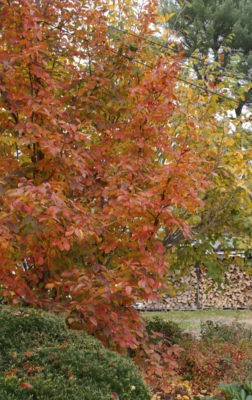
Stewartia in autumn
•Fothergilla (Fothergilla major) also earns its keep for much of the year, with bottlebrush clusters of fragrant, white flowers in spring and leaves that turn brilliant shades of yellow, orange and red in autumn.

Fothergilla in autumn
•Korean mountainash (Sorbus aucuparia) bears flat-topped clusters of white flowers in spring. In autumn, leaves take on a yellow color enriched with some brown and hints of red. Clusters of red fruits also ripen in fall. They’re small, but edible, a nice nibble.
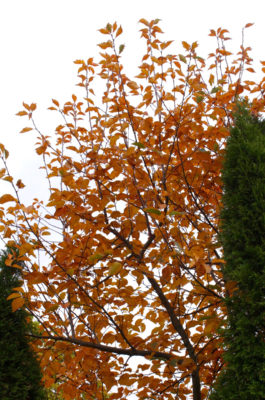
Korean mountainash in auatumn
•Pawpaw (Asimina triloba) bears large leaves that have lost their summer-y, tropical look and have turned a clear yellow. The large fruits, also with tropical aspirations, have been ripe for a few weeks, with flavors akin to vanilla custard, banana, or crème brûlée. Take your pick.

Pawpaw, autumn leaf color



